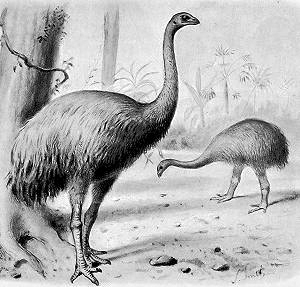- Giant Moa
Taxobox
name = "Dinornis"
image_width = 250px
image_caption = Life restoration of "Dinornis"
status = EX
extinct = "c."1500
regnum =Animal ia
phylum = Chordata
classis = Aves
superordo =Paleognathae
ordo =Struthioniformes
familia = Dinornithidae
genus = "Dinornis"
genus_authority = Owen,1843
subdivision_ranks = Species
subdivision =North Island Giant Moa, "D. novaezelandiae" (type) Slender Moa, "D. robustus" "Dinornis" new lineage A (undescribed taxon) "Dinornis" new lineage B (undescribed taxon)
synonyms = "Palapteryx" Owen,1851 The giant moa ("Dinornis") is an extinct genus of
ratite birds belonging to themoa family. It was endemic toNew Zealand . "Dinornis" may have been the tallest bird that ever lived, with the females of the largest species standing 3.6 m (12 ft)fact|date=July 2008 tall, and one of the most massive, weighing convert|230|-|240|kg|lbcite journal | last = Amadon | first = D. | year = 1947 | title = An estimated weight of the largest known bird | journal = Condor | volume = 49 | issue = | pages = 159–164 | doi =] or convert|278|kg|lbcite journal | last = Campbell, Jr. | first = K. | coauthors = Tonni, Eduardo | year = 1992 | title = The relationship of hindlimb bone dimensions to body weight in birds | journal = Science Series | publisher = Natural History Museum of Los Angeles County | volume = 36 | issue = | pages = 395–412 | doi =] in various estimates.Feather remains are reddish brown andhair -like, and apparently covered most of the body except the lower legs and most of the head (plus a small portion of the neck below the head). The feet were large and powerful, and the birds had a long neck that allowed them to reach tall vegetation. In relation to its body, the head was small, with a pointed, short, flat and somewhat curved beak. Overall, the giant moa probably resembled a heavyostrich . They filled the sameecological niche as grazingmammal s on thecontinent s.The giant moa, along with other moa genera, were wiped out by
human colonists who hunted it for food. All taxa in this genus were extinct by1500 in New Zealand. It is reliably known that theMaori s still hunted them at the beginning of the fifteenth century, driving them into pits and robbing their nests. The most important factorFact|date=March 2008 was farming, however, for which the forests were cut and burnt down and the ground was turned into arable land.The moa seems to have died out at the end of the fifteenth century.
Taxonomy
Three species of "Dinornis" were long considered valid:
* "D. giganteus" = "D. robustus",
* "D. novaezealandiae",
* "D. struthioides". They have recently turned out to be males ("struthioides") and females of only two species, one each formerly occurring on New Zealand's North Island ("D. novaezealandiae") and South Island ("D. robustus") (Huynen "et al"., 2003; Bunce "et al"., 2003); the North Island specimens, however, contain 3 distinct genetic lineages and may eventually be classified as new species (Baker "et al.", 2005).References
* Baker, Allan J.; Huynen, Leon J.; Haddrath, Oliver; Millar, Craig D. & Lambert, David M. (2005): Reconstructing the tempo and mode of evolution in an extinct clade of birds with ancient DNA: The giant moas of New Zealand. "
PNAS " 102(23): 8257-8262. DOI:10.1073/pnas.0409435102 [http://www.pnas.org/cgi/reprint/102/23/8257 PDF fulltext] [http://www.pnas.org/cgi/content/full/0409435102/DC1 Supporting Information]
*Benes, Josef. Prehistoric Animals and Plants. Pg. 191. Prague: Artia, 1979.
* Bunce, Michael; Worthy, Trevor H.; Ford, Tom; Hoppitt, Will; Willerslev, Eske; Drummond, Alexei & Cooper, Alan (2003): Extreme reversed sexual size dimorphism in the extinct New Zealand moa "Dinornis". "Nature" 425(6954): 172-175. DOI:10.1038/nature01871 [http://dx.doi.org/10.1038/nature01871 HTML abstract] [http://www.nature.com/nature/journal/v425/n6954/suppinfo/nature01871.html Supplementary information]
* Huynen, Leon J.; Millar, Craig D.; Scofield, R. P. & Lambert, David M. (2003): Nuclear DNA sequences detect species limits in ancient moa. "Nature" 425(6954): 175-178. DOI:10.1038/nature01838 [http://dx.doi.org/10.1038/nature01838 HTML abstract] [http://www.nature.com/nature/journal/v425/n6954/suppinfo/nature01838.html Supplementary information]
* Owen, Richard (1843): [On the remains of "Dinornis", an extinct gigantic struthious bird.] "Proceedings of the Zoological Society of London" 1843: 8-10, 144-146.
Wikimedia Foundation. 2010.
